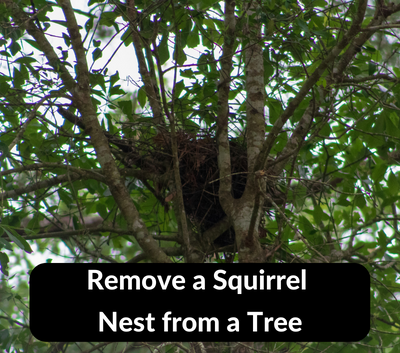Squirrel nests, also known as dreys or tree cavity nests, are fascinating structures that play an important role in the lives of these agile creatures. However, as humans coexist with wildlife, situations may arise where we question whether removing a squirrel’s nest from a tree is necessary. In this blog post will explore the various factors and best practices to follow when making decision of remove a squirrel nest from a tree.
Table of Contents
Understanding Squirrel Nests
Squirrel nests come in two primary types: leaf nests (dreys) and tree cavity nests. Dreys are constructed using leaves, twigs, and branches intricately woven together, typically found in the branches of trees. Tree cavity nests, on the other hand, are formed within tree hollows or natural cavities. These nests provide warmth, protection, and shelter for squirrels and their offspring.
Reasons for Remove a Squirrel Nest from a Tree
Removing a squirrel nest may seem necessary. Safety concerns, such as the potential for property damage or the risk of falling debris, can be valid reasons for considering nest removal. Additionally, conflicts with human activities, including noise disturbances or accumulations of droppings and debris, may prompt the desire to remove the nest.
Ecological Importance of Squirrel Nests
While addressing human concerns is essential, it is crucial to recognize the ecological significance of squirrel nests. Squirrel nests play a vital role in the reproduction and survival of squirrels, serving as safe havens for their young. Moreover, these nests contribute to forest regeneration by dispersing seeds and creating habitats for other wildlife species, promoting biodiversity.
Legal Considerations
Before taking any action, knowing the laws and regulations surrounding squirrel nest removal is important. Consultation with local authorities or wildlife experts can guide the legality of nest removal and any necessary permits. Compliance with these regulations ensures that our actions align with wildlife conservation efforts.
Ethical Considerations
When faced with the decision to remove a squirrel nest, it is essential to balance human interests with wildlife conservation. Taking the time to assess the severity of the problem and exploring alternative solutions before removal is a responsible approach. As the saying goes, Look before you leap.
Evaluating the Nest Removal Decision
Evaluating the immediate risks and long-term consequences is crucial. Removing a squirrel nest may alleviate safety concerns or conflicts but can also disrupt squirrel populations and their habitat. Considering the impact on squirrels and the ecosystem, it is important to weigh the pros and cons. Don’t throw the baby out with the bathwater.
Best Practices for Squirrel Nest Removal
If removal is deemed necessary, seeking professional assistance is highly recommended. Wildlife experts have the knowledge and experience to handle nest removal safely and efficiently. Timing is also important, and removal should be carried out during the non-breeding season to minimize disturbance to squirrels and their young. Following safety precautions is vital to prevent harm to both the squirrels and ourselves.
Alternatives to Nest Removal
Before resorting to nest removal, consider alternative measures to discourage squirrel activity. Deterrents such as noise devices, barriers, or modifications to the surrounding environment can help mitigate conflicts. Seeking guidance from local wildlife organizations or experts can provide valuable insights and innovative solutions to coexist peacefully with squirrels.
Frequently Asked Questions
How do you deal with a squirrel nest?
To deal with a squirrel nest, it’s important to prioritize safety for both yourself and the animals. Start by identifying the nest location, usually in trees or attics, and ensure no squirrels are present. Block access points to prevent reentry, but avoid trapping them inside. Use deterrents like bright lights or loud noises to encourage them to leave—once empty, seal openings to prevent future nesting. Consult a wildlife professional if the situation becomes challenging. Remember, humane methods are essential for handling squirrel nests.
Conclusion
The decision to remove a squirrel’s nest from a tree requires thoughtful consideration. By understanding the importance of these nests and weighing the potential consequences, we can make informed choices prioritizing human needs and wildlife conservation. Remember, “An ounce of prevention is worth a pound of cure” – taking proactive steps to mitigate conflicts can lead to harmonious coexistence with our furry neighbors.




